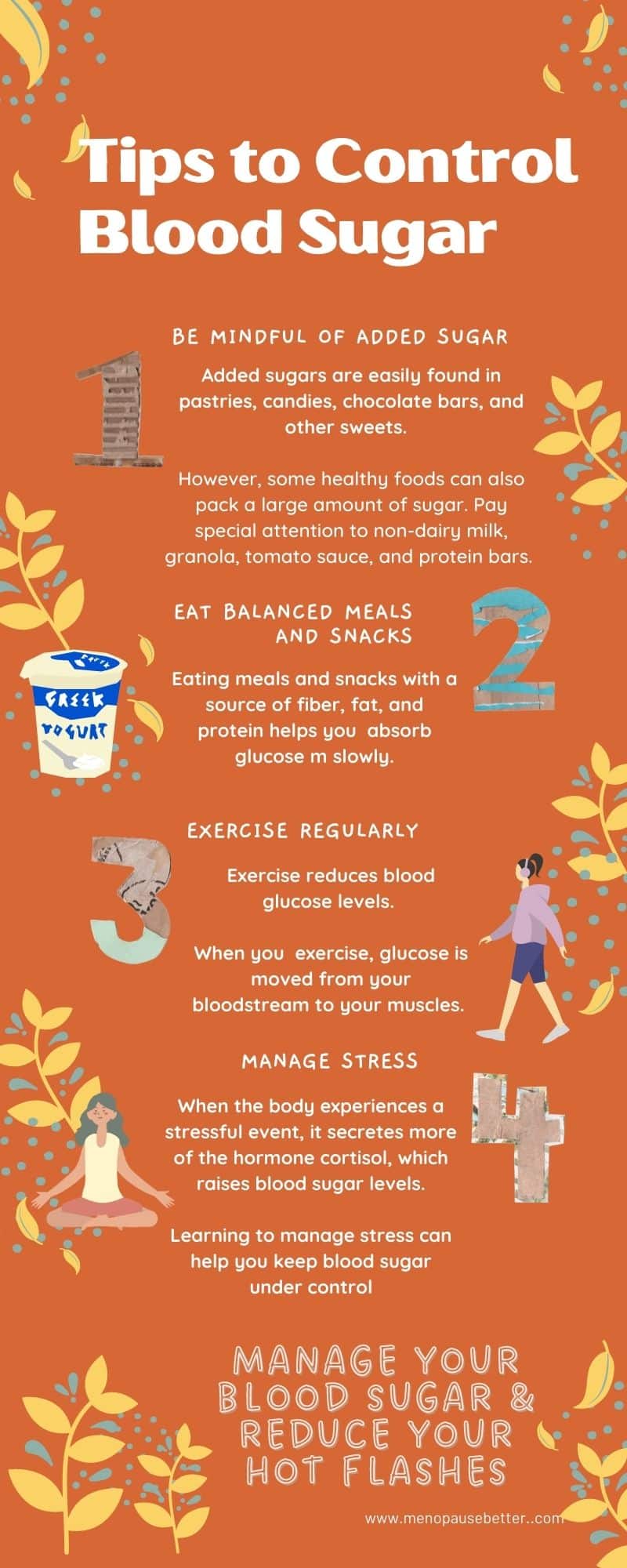Sugar and Hot Flashes: Is There a Link
A hot flash is an intense feeling of sudden warmth within the body, particularly over the face, neck, and chest. It’s accompanied by sweating and flushed skin, and it can be embarrassing and difficult to control.
Table of Contents
ToggleBut have you heard that lowering your blood sugar levels may help control this common symptom of menopause? Can eating less sugar help with hot flashes? This blog post will explore what science has to say about the connection between sugar and hot flashes.
What is Blood Sugar?
The blood sugar level (also known as blood glucose level) is the measure of glucose in the blood.
When you eat carbohydrates, your stomach digests food down into glucose and other parts. Glucose is a simple sugar, and it’s the body’s preferred source of fuel. The small intestine absorbs glucose and moves it into the bloodstream.
When the amount of sugar in your blood increases, the pancreas is signaled to release insulin. That lowers sugar levels by allowing glucose to flow into cells in the body to use as fuel or store for later.
Eating something that contains a lot of sugar, like a chocolate chip cookie, will result in a lot of glucose entering the bloodstream all at once. That requires a lot of insulin to bring the level back down.
Chronically high blood sugar can provoke your cells to stop responding properly to insulin. When this happens, it’s known as insulin resistance. Over time, the pancreas becomes unable to produce enough insulin to allow all the glucose to enter the cells. This means that glucose remains in the bloodstream and blood sugar level stays high.
Blood Glucose and Hot Flashes

In the Study of Women’s Health Across the Nation, 3,075 women 42-52 years of age were studied for 8 years. Researchers found that the participants who reported hot flashes 1 to 5 days per week had blood glucose levels 33% higher than participants who reported no hot flashes at all.
Women undergo a number of changes during menopause that can cause high blood sugar levels and incite more hot flashes.
What Causes High Blood Sugar?
During menopause, there are many reasons for blood sugar to increase.
Diabetes
Diabetes is a chronic metabolic disorder in which the body is unable to properly regulate blood glucose.
The primary symptom of diabetes is hyperglycemia (high blood sugar), which occurs when the body doesn’t produce enough insulin or when it can’t properly use the insulin it produces.
When this happens, glucose remains in the bloodstream instead of going into the cells to create energy.
Hormonal Changes
The hormone estrogen plays a role in controlling blood sugar levels by increasing the sensitivity of cells to insulin. Women experience an abrupt decrease in estrogen during menopause, which can cause high blood sugar levels and more hot flashes.
One study found that women with lower concentrations of estrogen during the menopausal transition had a 47% higher risk of developing high blood sugar.
Weight Gain

Another reason why women may develop excess blood glucose and experience hot flashes more frequently during menopause is weight gain.
Due to hormonal changes during this time, perimenopausal women experience a decrease in lean body mass. Without changing your diet and exercise routine to compensate, this loss of lean body mass can lead to weight gain over time.
Additionally, women experiencing menopause are prone to developing more visceral fat (the fat that lies within the innermost parts of the abdominal cavity).
Accumulation of belly fat is particularly problematic because it causes weight gain and increases the risk of developing insulin resistance. It also contributes to a greater risk of heart disease and type 2 diabetes.
Since women who have high blood sugar levels have more frequent and severe hot flashes, weight control is extremely important for women entering menopause.
Sleep Problems

Many women also experience problems getting sufficient sleep during menopause. Several studies have linked a lack of sleep to obesity, type 2 diabetes, high blood sugar levels, and insulin resistance. That means that poor sleep is another trigger for hot flashes.
Women already experience an increase in the stress hormone cortisol during menopause.
Sleep deprivation can increase cortisol levels even more. Cortisol breaks down glycogen, which is the stored form of glucose in cells, and increases the amount of glucose in the bloodstream.
Furthermore, lack of sleep can lead to reduced glucose tolerance—the ability of the body to clear glucose from the bloodstream. There is also some evidence that waking up several times throughout the night can also reduce how well the cells respond to insulin.
As you can see, a good night’s sleep is absolutely vital to regulating several processes in the body, including blood sugar. Managing these processes can lead to fewer hot flashes for women during menopause.
Tips to Control Blood Glucose and Avoid Hot Flashes
There are easy lifestyle changes you can make to lower your glucose levels and improve insulin sensitivity during menopause, which may decrease the frequency of hot flashes.
Be Mindful of Added Sugar

Although it’s okay to indulge in dessert once in a while, the American Heart Association recommends limiting added sugars to no more than 25 grams per day.
Added sugars contain very few nutrients but add extra calories that can lead to weight gain. More importantly, having too much-added sugar in your diet can cause chronically high blood sugar levels and lead to insulin resistance.
Sugars are added during the processing of foods. They include table sugar, honey, and syrups. Added sugar can be found in just about any food, but you can find higher quantities in pastries, candies, chocolate bars, other sweets, and sweetened beverages.
However, some healthy foods can also pack a large amount of sugar. Pay special attention to non-dairy milk, granola, tomato sauce, and protein bars.
Added sugars can be found underneath the carbohydrate section on the nutrition facts label.
The natural sugar found in fruits is an important part of a well-balanced diet. The fiber in the fruit helps digest the sugar slowly and prevents those unwanted sugar spikes.
Eat Balanced Meals and Snacks
What do cookies, bread, cake, and rice have in common? They are all sources of carbohydrates in our diets.
Although some of these foods contain more sugar than others, they are all broken down into glucose in the stomach. When carbohydrates are eaten without any fiber, fat, or protein, the small intestine rapidly absorbs glucose into the bloodstream, causing the blood sugar level to rise.
Eating carbohydrates with a source of fiber, fat, and protein enables the small intestine to absorb glucose more slowly, and you will avoid that rapid increase.
You can apply this tip when eating a meal or snack or when indulging in a sweet treat.
The next time you want to have a chocolate chip cookie, try having some Greek yogurt (protein) with a spoonful of chia seeds (fiber) and a handful of walnuts (fat).
This combination will also keep you fuller longer than eating a cookie by itself. Also, eat only ONE cookie.

Exercise Regularly
Exercise reduces blood glucose levels. When you go for a walk, lift weights, cycle, take a yoga class, or engage in any kind of exercise, glucose is moved from your bloodstream to your muscles. So, an exercise routine can reduce your risk of developing type 2 diabetes and insulin resistance.
Walking for just 10 minutes after each meal is an easy way to incorporate exercise into your daily life.
Manage Stress
When the body experiences a stressful event, it secretes more of the hormone cortisol, which raises blood sugar levels.
Employing stress reduction techniques, such as yoga, meditation, or deep breathing can improve your body’s response to stress. Another important stress reduction technique is making sure that you get enough uninterrupted sleep every night. Seven to nine hours per night is ideal enough for most adults.
One study found that stress management interventions can even lower glucose levels in patients with diabetes.

The Bottom Line
Keeping your glucose levels in check during menopause may help reduce the number of hot flashes that you experience. There are a number of things you can do to lower your blood glucose levels, including being mindful of added sugar, eating balanced meals and snacks, exercising regularly, and managing stress.
Managing blood sugar levels can reduce your risk of developing insulin resistance and diabetes during menopause.
“Sugar and Hot Flashes” was written by soon-to-be Registered Dietitian Emily Carney. Edited by Dr. Su-Nui Escobar, RDN.

Dr. Su-Nui Escobar, a Registered Dietitian/Nutritionist in Miami, FL, is dedicated to empowering women in perimenopause and menopause to live healthier, more satisfying lives.
With a doctorate in clinical nutrition from the University of North Florida, she has expertise in menopause and weight loss, including the unique challenges faced by those on weight loss medications.
Su-Nui’s passion for her field is evident in her previous role as the Academy of Nutrition and Dietetics spokesperson.


